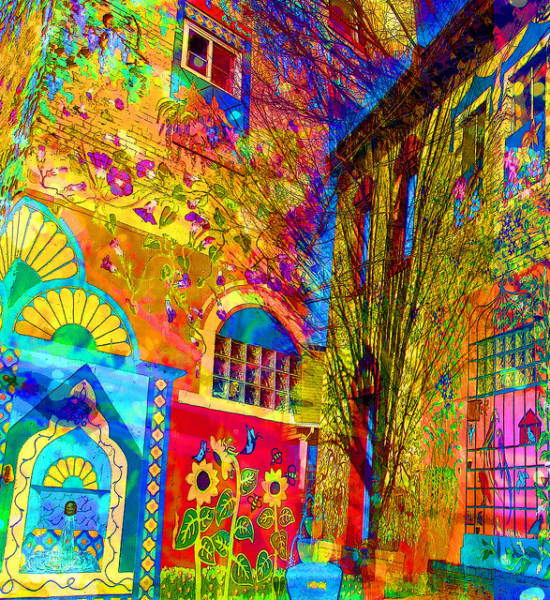One of the highlights of this year’s Independent Sector conference was a tour through the formerly depressed neighborhood of Wynwood, near central Miami. Conference-goers saw firsthand how waves of graffiti art had transformed mean streets into blocks of “cupcake spaces,” tech companies, and trendy clothing shops.
Wynwood got me thinking about other American neighborhoods whose economic fortunes changed in the hands of artists. Of course, economic stimulus should never be the primary goal of an artistic effort, but it can be a welcome byproduct.
Here’s a brief tour of some similar success stories.

Winning with Wynwood Walls – Miami, FL
“A few years ago, you could roll a bowling ball down the middle of the street in Wynwood, and no one would care,” said Jessica Goldman Srebnick, CEO of the real estate firm that led the Wynwood Walls development project.
Since the project launched in 2010, the neighborhood’s signature windowless warehouse buildings have been painted over by more than 50 artists from 16 countries. Today, it’s one of the largest permanent outdoor mural exhibits in the world.
It’s also provided a crucial injection of creative energy, which has helped to spur an artistic and economic renaissance of Miami’s urban core. Coinciding with the development of Wynwood Walls was the opening of the Perez Art Museum on Miami’s waterfront and an influx of educated, young people who now want to live downtown. According to City Observatory, 25 percent more 25- to 34-year-olds with a college degree have moved to central Miami over the past decade.
Photo by Joe Anzalone / CC BY

Money in the Bank – Chicago, IL
In 2012, artist Theaster Gates bought a landmark 1920s South Side Chicago bank for $1. Abandoned for years, the building appeared destined for the wrecking ball.
Where others saw urban blight, Gates said in a recent TED Talk – he had visions of a “miniature Versailles.” He turned the entire structure into a work of art – removed pieces of the marble walls and cut them into “bond certificates” bearing the phrase, “In ART We Trust.” According to CityLab, Gates sold the 100 marble tablets for $5,000 each, which helped to raise the $3.7 million he needed to rehabilitate the building. Gates estimates that he has invested $20 million into the South Side neighborhood over the past five years.
Photo by Steven Vance / CC BY

Streets Paved with Gold – Philadelphia, PA
For years, the Philadelphia Badlands has conjured images of street gangs and open-air drug markets. A group of activists and artists in the Centro de Oro (“Center of Gold”) are working to change that. As Hidden City Philadelphia reports, “in 2011, the neighborhoods’s sidewalks were literally paved with ‘gold,’ a swirling deep yellow path set in freshly poured concrete infused with brilliant glitter that sparkles in the sun. This $3.8 million dollar streetscape improvement was funded by the city and state.”
Led by groups like the Hispanic Association of Contractors and Enterprises – mural programs, Latin American folk dancers, paintings, sculptures, and a bustling music store have offered a more well rounded portrait of this predominantly Puerto Rican community. Urban gardens now decorate this corridor with fresh flowers, vegetables, and herbs.
Photo by brillianthues / CC BY

Making Magic in College Hill – Macon, GA
The city of Macon was once home to the Allman Brothers Band, Little Richard, and Otis Redding. After World War II, the former textile city fell on hard times. Jobs evaporated, and families moved out to the suburbs. According to the John S. and James L. Knight Foundation, Macon’s median household income was $23,127 in 2012 – less than half of the median income in Georgia and nationwide.
The Knight foundation has since made a pet project out of the historic neighborhoods that link Mercer University to the downtown area. It invested $3 million for a Knight Neighborhood Challenge “to give the city an opportunity to actively participate in a wide array of community arts, cultural and sports activities, and to connect through digital and traditional information gathering/sharing channels.”
The funding has indeed spurred the local arts scene – such as the Free Little Libraries pictured here. A Second Sunday Concert Series regularly draws 2,000 people. Neighbors have planted 250 trees and congregate around a newly installed 67-foot outdoor slide (perhaps stretching the boundaries of the term “arts”). According to Knight, College Hill property values have increased 34 percent from 2002 to 2011, compared to 21 percent for Macon as a whole.
Image credit: littlefreelibrary.org

Beautifying Bushwick – Brooklyn, NY
Here in our own backyard, the north Brooklyn neighborhood of Bushwick has boasted a burgeoning visual arts scene. Memories of the looting and vandalism that followed the 1977 blackout were nearly wiped away by the Department of Housing Preservation and Development’s Bushwick Initiative in 2006. What followed was a flurry of hip, small art galleries – as well as larger efforts like the Bushwick Open Studios.
All this begs the question: which NYC neighborhood will become the “new Bushwick”?
Photo by Hrag Vartanian / CC BY